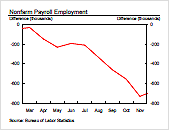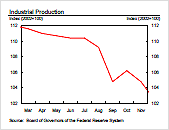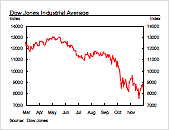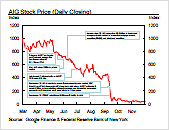|
||||||||||||||||||||||||||||||||||||||||||||||||||||||||||||||||||||||||||||||||||||||||||||||||||||||||||||||||||||||||||||||||||||||||||||||||||||||||||||||||||||||||||||||||||||||||||||||||||||||||||||||||||||||||||||||||||||||||||||||||||
|
Background
The fall of 2008 was a time of severe economic distress, marked by a broad-based decline in home prices, a rise in delinquencies and foreclosures, and a substantial drop in the values of mortgage-backed securities and other related instruments. Major institutions, including IndyMac Bank and Lehman Brothers, experienced debilitating losses that eventually led to their collapse, while Fannie Mae and Freddie Mac were placed into government conservatorship. There was a growing loss of confidence in U.S. and global financial markets, and credit markets were virtually frozen. Money market funds, long viewed as a safe investment by millions of Americans, were experiencing massive withdrawals. The run on these funds, in turn, severely disrupted the commercial paper market, a vital source of funding for American businesses. Securitization markets started to seize up, especially those reliant on instruments backed by consumer loans. Banks sharply curtailed their lending. A full-fledged panic had started and was spreading rapidly. The effects of the crisis extended well beyond Wall Street. State governments faced significant budget shortages; schools, universities and hospitals curtailed spending; and large and small businesses came under pressure to cut costs and eliminate jobs, leaving millions of Americans unemployed.
AIG, the world's largest insurance company and a major participant in the global trade of derivatives and other financial instruments, was encountering severe liquidity problems, primarily as a result of losses on its mortgage-related investment portfolio and collateral calls on credit default swaps (CDS) and other financial contracts. By mid-September 2008, these liquidity pressures brought the firm to the brink of collapse. On September 15, 2008, downgrades by certain credit rating agencies triggered CDS-related collateral calls that the company could not meet. In light of the unusual and exigent circumstances at the time, the New York Fed and the Board of Governors of the Federal Reserve System—in close cooperation with the U.S. Department of the Treasury—made the decision to intervene to prevent the imminent collapse of AIG. The decision to lend to AIG was motivated by a single goal: to protect the U.S. and global economies and the American people from the devastating effects that its disorderly failure would have caused in the then prevailing economic environment. The first response of policymakers to the crisis at AIG was to encourage a private-sector solution. A consortium of private-sector financial institutions was convened at the New York Fed, but specific terms for an AIG financing package could not be agreed upon. At the time of AIG's liquidity crisis, no effective bankruptcy framework existed for a firm of AIG's type and size. There was no single regulator to step in and manage the company's failure, no single court that could sort out the demands of creditors and shareholders, and no practical way to coordinate among the hundreds of U.S. and foreign regulators responsible for overseeing all of AIG's businesses. The absence of a resolution authority, combined with the size and scope of AIG's businesses and the existing stress on the economy, would have made the consequences of its failure potentially catastrophic, stressing the need for quick, effective action.
Consequences of an AIG Failure
The failure of AIG, a company with more than 76 million customers in approximately 140 countries—more than 30 million customers in the United States alone—posed a direct threat to millions of policyholders, state and local government agencies, 401(k) participants, banks and other financial institutions in the United States and abroad, and would have shattered confidence in already fragile financial markets.
If AIG had been allowed to fail and the parent company had filed for bankruptcy, the consequences and effects could have been severe:
Given the unusual and exigent circumstances at the time, the potentially far-reaching consequences of an AIG bankruptcy compelled policymakers to take decisive action to intervene.
Key Dates and Actions
The Board of Governors of the Federal Reserve System, relying on its emergency authority granted by Congress under section 13(3) of the Federal Reserve Act and mindful of its responsibility to maintain financial stability and with the full support of the U.S. Treasury Department, authorized the New York Fed to extend a secured revolving credit facility of up to $85 billion to AIG. The New York Fed extended that credit to AIG, and the company agreed to transfer a controlling stake of 79.9 percent of company equity to a trust for the sole benefit of the United States Treasury. AIG's chief executive officer was also replaced. The credit facility initially carried a rate of LIBOR plus 8.5 percent—comparable to the terms contemplated by the consortium of private banks that explored a private-sector solution. The credit facility was secured by a pledge of a substantial portion of AIG's assets.
The initial emergency $85 billion facility successfully stabilized AIG in the short term, but the company's financial condition and capital structure remained vulnerable to further deterioration in difficult market conditions. In October 2008, borrowing costs continued to rise, credit markets remained essentially frozen and equity markets trended downward.
The Board of Governors approved an additional secured credit facility that permitted the New York Fed to borrow up to $37.8 billion of investment-grade, fixed-income securities from certain regulated U.S. insurance subsidiaries of AIG in return for cash collateral. By November 20, 2008, AIG received approximately $20 billion in cash collateral under the program, which was returned in full when the program was terminated on December 12, 2008, in connection with the formation of the Maiden Lane II facility (see below).
Additionally, toward the end of October 2008, four AIG affiliates began participating in the Federal Reserve's Commercial Paper Funding Facility (CPFF) on the same terms and conditions as other participants in the program. The CPFF program ended in April 2010 without incurring any credit losses.
Despite having access to these additional credit facilities, AIG continued to face serious liquidity pressures related to losses on residential mortgage-backed securities, and its exposure to CDS contracts.
The Board of Governors and the U.S. Treasury Department announced the restructuring of financial support to AIG in order to provide the company more time and greater flexibility to sell assets and repay that support. Measures included certain modifications to the New York Fed's credit facility, including a reduction of the interest rate to three-month LIBOR plus 300 basis points, and a reduction of the fee charged on undrawn funds to 75 basis points (from the then-existing rate of 850 basis points). The length of the facility was also extended from two years to five years. In addition, the U.S. Treasury Department announced its plan to purchase $40 billion of newly issued AIG preferred shares under the Troubled Asset Relief Program (TARP), the proceeds of which were used to reduce the balance of the Fed's credit facility. The total amount available to AIG under the credit facility was also reduced from $85 billion to $60 billion.
Finally, the Board of Governors, relying on its emergency authority granted by Congress under section 13(3) of the Federal Reserve Act, approved the creation by the New York Fed of two new secured lending facilities designed to alleviate capital and liquidity pressures on AIG associated with two distinct portfolios of mortgage-related securities. These new facilities resulted in the creation of two new special purpose vehicles (SPVs): Maiden Lane II LLC and Maiden Lane III LLC.
The New York Fed, with the full support of the U.S. Treasury Department, established the AIG Credit Facility Trust to hold the controlling equity interest in AIG. The Trust was established for the sole benefit of the United States Treasury, the general fund of the U.S. government, and thus effectively for the benefit of U.S. taxpayers. The New York Fed appointed three independent trustees to control the Trust.
The U.S. Treasury Department and the Federal Reserve announced the outline of a restructuring of assistance to AIG designed to strengthen the company's capital position and provide it with additional time to restructure and strengthen its finances. The measures included an authorization by the Board of Governors for the New York Fed to acquire up to $26 billion of preferred interests in special purpose vehicles formed to hold two of AIG's largest foreign life insurance subsidiaries: American International Assurance Co., Ltd. (AIA), and American Life Insurance Company (ALICO), in satisfaction of an equivalent amount of the outstanding balance of, and the amount available under, the credit facility. This step was intended to reduce AIG's financial leverage, and thus relieve pressures on the credit ratings of the parent company. Acquiring the preferred interest also facilitated the independence of these two subsidiaries in anticipation of their eventual sale or initial public offering. Additional measures included a reduction in the interest rate on the credit facility; changes to the terms of the U.S. Treasury Department's existing TARP investment; the establishment of an additional TARP facility of up to approximately $29.8 billion that AIG could draw upon as needed in exchange for the issuance of additional preferred equity to the Treasury Department; and the authorization by the Board of Governors of a potential securitization of certain life insurance cash flows in amounts up to $8.5 billion. Â In February 2010, AIG announced that it would not pursue the securitization option.
In accordance with the restructuring announced on March 2, 2009, the New York Fed agreed to receive from AIG $16 billion of preferred equity in the SPV formed to hold AIA and $9 billion of preferred equity in the SPV formed to hold ALICO in satisfaction of an equivalent amount of the outstanding balance of, and amount available under, the revolving credit facility.
The New York Fed received preferred interests in the AIA and ALICO SPVs, and accordingly reduced the outstanding balance of, and amount available under, the $60 billion revolving credit facility by $25 billion. The New York Fed's preferred interests earned an annualized return of 5 percent. Under the terms of the transaction, subject to certain limited exceptions, all proceeds from the voluntary sale, public offering or other liquidation of the assets or businesses held by the SPVs were required to first be used to redeem the New York Fed's preferred interests until those interests were redeemed in full.
AIG agreed to sell AIA to U.K.-based insurer Prudential plc. for $35.5 billion. Following further negotiations, the deal was terminated by the companies on June 2, 2010. AIG subsequently announced plans to conduct an initial public offering of AIA (see below).
AIG announced the sale of ALICO to U.S.-based insurer MetLife, Inc., for approximately $15.5 billion, including $6.8 billion in cash. Net cash proceeds from the sale were required to partially redeem the New York Fed's preferred interests in the ALICO SPV. The MetLife securities received in the transaction as noncash consideration were sold over time to further redeem the New York Fed's preferred interests and subsequently to reduce the outstanding balance of the credit facility.
AIG announced plans to conduct an initial public offering of AIA by seeking a listing of AIA on the Hong Kong Exchange, subject to regulatory approvals and market conditions. The proceeds were to be used to redeem the New York Fed's preferred interests in the AIA SPV and subsequently to reduce the outstanding balance of the credit facility.
AIG announced an agreement with the U.S. Department of the Treasury, the New York Fed and the trustees of the AIG Credit Facility Trust on a comprehensive recapitalization plan designed to repay all its obligations to American taxpayers. The measures include an accelerated repayment and termination of the New York Fed's credit facility, the acquisition of the majority of the New York Fed's preferred interests in the AIA and ALICO special purpose vehicles by the U.S. Treasury Department, and the conversion of the AIG preferred stock currently owned by the Treasury Department and the Credit Facility Trust into common equity.
AIG announced that it raised approximately $36.7 billion in gross proceeds to repay a significant portion of the government's assistance to AIG through its sale of American Life Insurance Company (ALICO) and the initial public offering of AIA Group Limited (AIA). On November 1, AIG closed the sale of ALICO to MetLife, Inc. for approximately $16.2 billion, including approximately $7.2 billion in cash and the remainder in MetLife securities. On October 29, AIG received gross proceeds from the initial public offering of AIA totaling approximately $20.51 billion (including the exercise of the over-allotment option granted to the underwriters). Under the terms of the recapitalization plan announced by AIG on September 30, 2010, the net cash proceeds of these transactions (totaling approximately $26.9 billion), as well as certain additional proceeds from future asset dispositions, were held by the New York Fed as agent for the special-purpose vehicles created to hold AIA and ALICO, AIA Aurora LLC and ALICO Holdings LLC. At the closing of the recapitalization plan, the proceeds were applied first as full repayment and termination of the credit facility extended to AIG by the New York Fed and then to redeem a portion of the New York Fed's preferred interests in AIA Aurora LLC and ALICO Holdings LLC. The MetLife securities received from the ALICO sale were sold over time, subject to certain lock-up provisions and market conditions, to provide additional funds to redeem the preferred interests.
The New York Fed, AIG, the U.S. Treasury Department and the trustees of the AIG Credit Facility Trust closed the recapitalization announced in September 2010, which was designed to accelerate the repayment of AIG's obligations to American taxpayers. With the closing of the recapitalization, the New York Fed's revolving credit facility was fully repaid, including interest and fees; its lending agreement and commitment terminated; and all of its remaining preferred interests in the AIA and ALICO special-purpose vehicles either redeemed by AIG or purchased and transferred to the U.S. Department of the Treasury. The accelerated repayment of the New York Fed freed up collateral that enabled the company to access private debt markets, an essential step toward facilitating the U.S. Department of the Treasury's sale of the common stock it owned as consequence of the recapitalization.
The New York Fed announced the sale of the remaining securities in the Maiden Lane II LLC (ML II) portfolio.* Net proceeds from sales of all the securities, as well as cash flow the securities generated while held by ML II, enabled the full repayment of the loan the New York Fed had made to ML II and resulted in a net gain for the benefit of the U.S. public.
The New York Fed announced the sale of the remaining securities in the Maiden Lane III LLC (ML III) portfolio. Net proceeds from sales of all the securities, as well as cash flow the securities generated while held by ML III, enabled the full repayment of the loans the New York Fed made to ML III and resulted in a net gain for the benefit of the U.S. public.
New York Fed's Role and Objectives
In connection with its assistance to AIG, the rights of the New York Fed were those of a creditor. From September 22, 2008, until its loans to AIG were repaid in full on January 14, 2011, the New York Fed operated under a credit agreement that contained significant conditions and protections to help ensure the full repayment of the loans, including accrued interest and fees. In its role as creditor, the New York Fed regularly received information from AIG regarding the company's financial condition and operations. The New York Fed, in coordination with the Treasury Department, worked with AIG management in ongoing efforts to implement of the company's business and restructuring strategy. In accordance with the terms of the credit facility, the New York Fed sent observers to each of the company's board of directors meetings. The New York Fed had a dedicated team, led by senior officials, whose sole role was to review AIG's financial condition, monitor the use of cash and exercise the New York Fed's contractual consent rights over decisions that could affect the company's ability to repay its loan. The team had frequent on-site contact with the company to ensure that the New York Fed was informed of AIG's funding needs, cash flows, liquidity, earnings, asset valuations and overall progress in pursuing corporate restructuring, including the divestiture of assets.
The New York Fed was also assisted by professional advisors in its daily monitoring of AIG. The New York Fed team's ongoing oversight of the company was supplemented by a number of firms in a range of fields, including accounting, investment banking, asset valuation and legal advice. Under the terms of the revolving credit facility, AIG reimbursed the New York Fed for advisory fees and other out-of-pocket expenses.
To the extent that the New York Fed was a party to certain transactions with the company, the New York Fed did, when appropriate, provide comments to certain AIG securities filings and related disclosures. Such comments were intended to strengthen the accuracy and consistency of the disclosure in question, and any such comments were provided with the full understanding that AIG is ultimately responsible for its own disclosure obligations under federal securities laws.
At the time it provided AIG with assistance, the New York Fed did not have statutory authority to supervise or regulate AIG or its subsidiaries. The company's regulated subsidiaries are supervised by numerous government bodies, which include U.S. state insurance regulators and the financial and insurance supervisors of many foreign jurisdictions. Also, as a publicly listed company in the United States, the parent company is subject to the rules and regulations of the U.S. Securities and Exchange Commission. AIG's management team and board of directors are responsible for the day-to-day management of the company, as well as for its accounting, auditing and controls.
|
||||||||||||||||||||||||||||||||||||||||||||||||||||||||||||||||||||||||||||||||||||||||||||||||||||||||||||||||||||||||||||||||||||||||||||||||||||||||||||||||||||||||||||||||||||||||||||||||||||||||||||||||||||||||||||||||||||||||||||||||||
|
*As part of the close-out procedures for Maiden Lane II LLC, on August 22, 2012, the New York Fed sold eight residual securities that had been factored to zero and consequently dropped from the portfolio holdings report published by the New York Fed. There was no active notional balance associated with these positions as the securities were fully written down prior to the last ML II sale on February 28, 2012; thus, the subsequent sale of these zero-factor securities had no material impact on the net gain reported for the ML II portfolio. |
||||||||||||||||||||||||||||||||||||||||||||||||||||||||||||||||||||||||||||||||||||||||||||||||||||||||||||||||||||||||||||||||||||||||||||||||||||||||||||||||||||||||||||||||||||||||||||||||||||||||||||||||||||||||||||||||||||||||||||||||||
|
New York Fed Financial Assistance to AIG
|
Billions of U.S dollars
|
Facility
|
Date of Issuance
|
Date of Close
|
Facility Limit and Maximum Amount Loaned
|
Total Interest and Fees Earned
|
|
AIG Revolving Credit Facility
|
September 2008 | Repaid in full on January 14, 2011 |
$851
|
$6.703 |
|
Preferred Interests in AIA Aurora LLC /ALICO Holdings LLC |
December 2009 | Repaid in full on January 14, 2011 | $25 | $1.444 |
| Securities Borrowing Facility | October 2008 | Repaid in full on December 12, 2008 | $37.8
$20.5 maximum loaned |
$0.085 |
Note: The table above does not include AIG affiliates' participation in the Federal Reserve's Commercial Paper Funding Facility (CPFF). The CPFF program ended in April, 2010 without incurring any credit losses.
More information on CPFF can be found here. ![]()
1 The original $85 billion commitment was reduced to $60 billion in November 2008 in connection with the $40 billion TARP investment in AIG. The credit facility commitment was further reduced to $35 billion in December 2009 in connection with AIG's transfer of the AIA Aurora LLC and ALICO Holdings LLC preferred interests to the New York Fed. Additional commitment reductions followed as AIG sold assets to repay the credit facility. The commitment was permanently terminated when AIG fully repaid the facility on January 14, 2011.
2 AIG's usage of the revolving credit facility peaked prior to the November 2008 restructuring, which reduced the commitment to $60 billion.
3 The credit facility initially carried an interest rate of LIBOR plus 8.5 percent, with a 3.5 percent floor on LIBOR. On November 25, 2008, the interest rate was reduced to LIBOR plus 3 percent, but the floor on LIBOR was retained. On April 17, 2009, the floor on LIBOR was eliminated. The interest rate on the facility was reset quarterly.
4 The dividend rate on the New York Fed's preferred interests in AIA Aurora LLC and ALICO Holdings LLC was fixed at 5 percent, compounded quarterly.
5 The overnight rate on the securities borrowing facility was a daily market rate, which varied by the type of collateral posted by AIG.
|
New York Fed Financial
Assistance to AIG-Related Facilities
|
| Maiden Lane Facilities as of 09/17/2014 ($ millions) | ||||||
| Original FRBNY
Senior Loan Balance |
Current Accrued Interest on Senior Loan | Cumulative Payments to FRBNY | Current Senior Loan Balance with Accrued Interest | H.4.1 Portfolio Holdings Fair Value1 | Net Realized Gain / Income for FRBNY2 | |
| Maiden Lane II LLC | $19,494 | - | $(22,393) | - | - | $2,899 |
| Maiden Lane III LLC | $24,339 | - | $(30,989) | - | - | $6,650 |
Source: Federal Reserve Board H.4.1, Federal Reserve Bank of New York.
Note: This table will be updated annually. Weekly updates can be found on the Federal Reserve Board H.4.1
1 Portfolios remarked quarterly. Reflects 6/30/2014 prices applied to the portfolio as of the reporting date.
2 Net realized gain/income figure includes accrued interest earned on the senior loan and any current residual balance paid to the New York Fed.
|
Date
|
Title
|
||
|
2015
|
|||
|
Dec 14, 2015
|
|||
|
2012
|
|||
|
Aug 23, 2012
|
|||
|
Feb 28, 2012*
|
|||
|
2011
|
|||
|
Oct 31, 2011
|
|||
|
Jan 14, 2011
|
|||
|
2010
|
|||
|
Nov 1, 2010
|
|||
|
Sep 30, 2010
|
|||
|
Sep 30, 2010
|
|||
|
Sep 30, 2010
|
|||
|
Jul 29, 2010
|
|||
|
Jul 9, 2010
|
|||
|
Jun 9, 2010
|
|||
|
May 26, 2010
|
|||
|
Mar 31, 2010
|
|||
|
Feb 26, 2010
|
|||
|
Jan 27, 2010
|
|||
|
Jan 19, 2010
|
|||
|
2009
|
|||
|
Nov 17, 2009
|
|||
|
Apr 28, 2009
|
|||
|
Mar 24, 2009
|
|||
|
Mar 24, 2009
|
|||
|
Mar 24, 2009
|
|||
|
Mar 5, 2009
|
|||
|
Mar 2, 2009
|
|||
|
Jan 16, 2009
Posted Jan 22, 2009 |
|||
|
Jan 16, 2009
|
|||
|
2008
|
|||
|
Dec 16, 2008
|
|||
|
Dec 3, 2008
|
|||
|
Nov 10, 2008
|
|||
|
Oct 8, 2008
|
|||
|
Sep 29, 2008
|
|||
|
Sep 16, 2008
|
|||
*As part of the close-out procedures for Maiden Lane II LLC, on August 22, 2012, the New York Fed sold eight residual securities that had been factored to zero and consequently dropped from the portfolio holdings report published by the New York Fed. There was no active notional balance associated with these positions as the securities were fully written down prior to the last ML II sale on February 28, 2012; thus, the subsequent sale of these zero-factor securities had no material impact on the net gain reported for the ML II portfolio.
|
The Federal Reserve recognizes the importance of transparency to its financial stability efforts, and has made a large amount of information available to the public since its original intervention in American International Group (AIG).
New York Fed officials have periodically appeared before Congress to discuss the New York Fed's intervention and provide briefings and information to multiple committees. The New York Fed has and will continue to cooperate with multiple Congressional bodies in their reviews of its actions, including the Congressional Oversight Panel, the Government Accountability Office, and the Special Inspector General for Troubled Asset Relief Program (TARP).
The Federal Reserve will continue to review its transparency policies with the goal of making additional information publicly available as appropriate. To further the goal of transparency, Chairman Bernanke has called for an audit by the Government Accountability Office of the Federal Reserve's involvement in AIG, which is fully supported by the New York Fed.
|


















 “We have provided and continue to provide this information because it is important that the Congress and the public understand that, in our actions regarding AIG, the Federal Reserve and the Treasury acted in the best interests of the United States to preserve the financial system and to protect households and businesses from potentially calamitous effects on the U.S. economy, while doing everything possible to protect the American taxpayer.”
“We have provided and continue to provide this information because it is important that the Congress and the public understand that, in our actions regarding AIG, the Federal Reserve and the Treasury acted in the best interests of the United States to preserve the financial system and to protect households and businesses from potentially calamitous effects on the U.S. economy, while doing everything possible to protect the American taxpayer.”
 “We are in favor of a full and objective review of our actions and look forward to the opportunity to document for the public and members of Congress our involvement in AIG. All of the Federal Reserve's actions regarding AIG were undertaken to protect the American people from an even more severe economic downturn and to safeguard U.S. taxpayers' interests in the company.”
“We are in favor of a full and objective review of our actions and look forward to the opportunity to document for the public and members of Congress our involvement in AIG. All of the Federal Reserve's actions regarding AIG were undertaken to protect the American people from an even more severe economic downturn and to safeguard U.S. taxpayers' interests in the company.”
